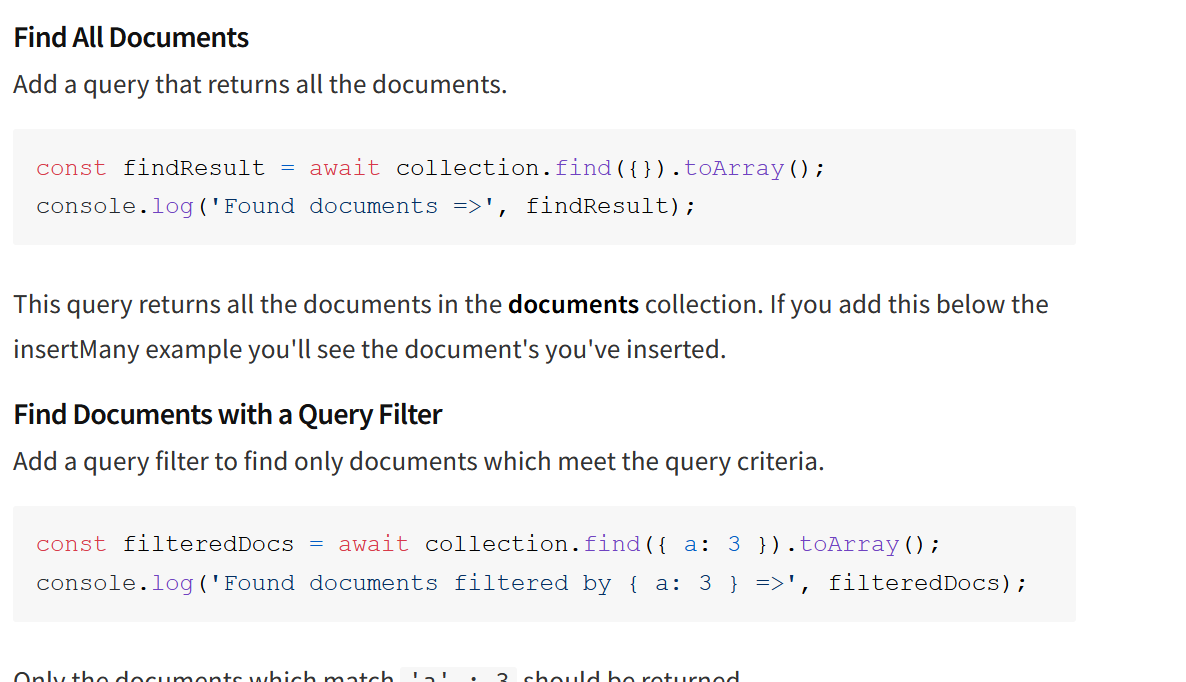NeDB for Node
Dr. Greg Bernstein
Updated November 13th, 2021
Data Persistence
References
Wikipedia NoSQL, Document-oriented Database
NeDB, nedb-promises We’ll use the promise version.
Why?
Part of a servers job is to be a data repository
Examples: web pages, templates, CSS files, images, user data
Why a Database?
- Why not just files in the file system?
- Databases bring
- Organization, fast lookups
- Good for lots of “little” data, rather than a file per item
Types of Databases
Relational: Traditional high performance databases used in business and elsewhere. Requires highly structured data. Open source examples: PostgreSQL, SQLite
Document Oriented: Less structured and more flexible than Relational. Easy to get started with. Examples: CouchDB, MongoDB, etc…
Graph Databases Wikipedia.
And more…
CRUD?
Basic Database Operations
Create: create “things” and insert them into the database
Read: lookup/search for “things” in the database and read them
Update: update “things” already in the database
Delete: delete “things” from the database
Example Document Database
JavaScript Document Database
“Embedded persistent or in memory database for Node.js, nw.js, Electron and browsers, 100% JavaScript, no binary dependency. API is a subset of MongoDB’s and it’s plenty fast.”
Installation
npm install nedb-promises --save
NEDBExamples.zip archive of examples from these slides.
MongoDB
From [MongoDB

MongoDB and Node.js
From NPM: mongodb official adapter

Database Creation and Storage
DataStore Concept
In NeDB a
db(datastore) is like a JavaScript array and it can hold arbitrary JavaScript objects (called documents)This is similar to a MongoDB collection
NeDB (like MongoDB) provides many methods for insert, update, find, and remove objects from these stores.
You can use multiple datastores in an application to hold different types of data.
File Based Persistence
Can set up NeDB for in-memory or file based use, we want file based. Use:
import DataStore from "nedb-promises";
const db = DataStore.create("./tempDB");Where /tempDB is the name I gave to this particular data file.
Document Creation
Document _id
- Every document (object) in a datastore needs an
_idproperty - It must be a string
- It must be unique (NeDB can generate these for us)
Inserting Documents
Single Insert
import DataStore from "nedb-promises";
const db = DataStore.create("./blogDB");
let blog1 = {_id: "0", title: "Python Snake or language",
content: `This will become the blog content. but for right now it is a placeholder`
};
db.insert(blog1); // Returns a promiseInserting Documents 1
Batch Insert: simpleDBInit.mjs
import DataStore from "nedb-promises";
const db = DataStore.create("./blogDB");
// In these examples we set the _id property
let blog1 = {
_id: "0",
title: "Python Snake or language",
content: `This will become the blog content. but for right now it is a placeholder`,
};
let blog2 = {
_id: "1",
title: "C++ Closer to the Metal",
content: `So powerful, but so error prone. Difficult to master.`,
};
let blog3 = {
_id: "2",
title: "JavaScript Browsers Friend",
content: `So powerful, no type checking. Keeps getting better.`,
};
db.insert([blog1, blog2, blog3])
.then(function (newDocs) {
console.log("Added " + newDocs.length + " docs");
})
.catch(function (err) {
console.log("Something went wrong when writing");
console.log(err);
});Inserting Documents 2
Let NeDB assign _ids (tasDBInit.mjs):
import { readFile } from "fs/promises";
import DataStore from "nedb-promises";
const db = DataStore.create("./tassieDB");
// Get sample data from JSON file
const mammals = JSON.parse(
await readFile(new URL("./Narawntapu.json", import.meta.url))
);
async function cleanAndInsert() {
// Clear out any existing entries if they exist
let numRemoved = await db.remove({}, { multi: true });
console.log("clearing database, removed " + numRemoved);
// We let NeDB create _id property for us.
let newDocs = db.insert(mammals);
console.log("Added " + newDocs.length + " mammals");
}
cleanAndInsert();Note on Example
Part of the Narawntapu.json file. Data from Tasmania Parks and Wildlife Service
[{"sciName": "Ornithorhynchus anatinus", "comName": "Platypus"},
{"sciName": "Tachyglossus aculeatus setosus" , "comName": "Echidna"},
{"sciName": "Antechinus minimus minimus", "comName": "Swamp Antechinus"},
{"sciName": "Dasyurus maculatus maculatus", "comName": "Spotted-tailed Quoll"},
{"sciName": "Dasyurus viverrinus", "comName": "Eastern Quoll"},
{"sciName": "Sarcophilus harrisii", "comName": "Tasmanian Devil"},A Peek at the file format 1
Right after initial inserts blogDB:
{"_id":"0","title":"Python Snake or language","content":"This will become the
blog content.\n\t\t\tbut for right now it is a placeholder"}
{"_id":"1","title":"C++ Closer to the Metal","content":"So powerful, but so
error prone.\n\t\t\tDifficult to master."}
{"_id":"2","title":"JavaScript Browsers Friend","content":"So powerful, no
type checking.\n\t\t\tKeeps getting better."}A Peek at the file format 2
NEDB assigned ids
{"sciName":"Potorous tridactylus apicalis",
"comName":"Potoroo","_id":"5D7Ow144oVfJZVS4"}
{"sciName":"Macropus rufogriseus rufogriseus",
"comName":"Bennetts Wallaby","_id":"8VFOq6jETFLLps6n"}
{"sciName":"Cercartetus nanus nanus",
"comName":"Eastern Pygmy Possum","_id":"9EdTSg2FrqWjVuU0"}
{"sciName":"Sarcophilus harrisii",
"comName":"Tasmanian Devil","_id":"9VhfxCg11W54Yx6n"}
{"sciName":"Dasyurus maculatus maculatus"
,"comName":"Spotted-tailed Quoll","_id":"CYXazYuO44GTg24M"}Searching the Database
Overview
From Finding Documents
Use find to look for multiple documents matching you query, or findOne to look for one specific document.
You can select documents based on field equality or use comparison operators ($lt, $lte, $gt, $gte, $in, $nin, $ne). You can also use logical operators $or, $and, $not and $where.
You can use regular expressions in two ways: in basic querying in place of a string, or with the $regex operator.
Finding Documents 1
Getting all the documents in a store simpleDBfinds.js
import DataStore from "nedb-promises";
const db = DataStore.create("./blogDB");
// Get all the documents in the database
db.find({}).then(function (docs) {
console.log("We found " + docs.length + " documents");
console.log(docs);
});Finding Documents 2
Lots of ways to find things in the datastore (findAnimals.mjs), example with string matching via regex:
import DataStore from "nedb-promises";
const db = DataStore.create("./tassieDB");
async function findThings() {
let docs = await db.find({});
console.log("We found " + docs.length + " Types of mammals");
console.log(docs);
// Get a list of all the types of Possums that live in the park:
// Using a JavaScript regular expression
docs = await db.find({ comName: /Possum/ });
console.log("We found " + docs.length + " Types of Possums");
console.log(docs);
// Get a list off all types of Bandicoot
// FYI https://en.wikipedia.org/wiki/Eastern_barred_bandicoot
docs = await db.find({ comName: /Bandicoot/ });
console.log("We found " + docs.length + " Types of Bandicoot");
console.log(docs);
// Kangaroos or Wallabys
// Use $or operator
docs = await db.find({
$or: [{ comName: /Kangaroo/ }, { comName: /Wallaby/ }],
});
console.log("We found " + docs.length + " Kangaroo like thing");
console.log(docs);
}
findThings();
JavaScript RegEx
"Are used with the exec and test methods of
RegExp, and with the match, replace, search, and split methods ofString.
JavaScript RegEx: Just a bit
RegEx literal
var myReg = /stuff between slashes/;^,$: Match begining and end of a line*,+: Matches preceding expression 0 (1) or more times.: Matches any single character
JavaScript RegEx: Hands on
mystring = "This is a message to CS351: Rule the web!"
mystring.match(/a mes/)
mystring.match(/a bmes/)
mystring.match(/^This/)
mystring.match(/^message/)Query Operators
From findAnimals.mjs:
// Kangaroos or Wallabys
// Use $or operator
docs = await db.find({
$or: [{ comName: /Kangaroo/ }, { comName: /Wallaby/ }],
});
console.log("We found " + docs.length + " Kangaroo like thing");
console.log(docs);Sorting and Pagination
From sortPagAnimals.mjs:
import DataStore from "nedb-promises";
const db = DataStore.create("./tassieDB");
async function lookThemUp() {
// Sort by common name, limit to the first 5
let docs = await db.find({}).sort({ comName: 1 }).limit(5).exec();
console.log("First 5 Sorted by Common name");
console.log(docs);
// The {"sciName": 1} argument to find restricts the fields that are returned
docs = await db.find({}, { sciName: 1 }).sort({ sciName: 1 }).limit(5).exec();
console.log("First 5 sorted by Scientific name");
console.log(docs);
}
lookThemUp();Projections
Restricting the document fields returned. From sortPagAnimals.mjs:
// The {"sciName": 1} argument to find restricts the fields that are returned
docs = await db.find({}, { sciName: 1 }).sort({ sciName: 1 }).limit(5).exec();
console.log("First 5 sorted by Scientific name");
console.log(docs);Counting
Use when you don’t need details back countAnimals.mjs
import DataStore from "nedb-promises";
const db = DataStore.create("./tassieDB");
// Count all
db.count({}).then(function (count) {
console.log(`We counted ${count} mammals`);
});
// count Devil
db.count({ comName: /Devil/ }).then(function (count) {
console.log(`We have ${count} type(s) of Devils`);
});Changing and Deletion
Updating
Lots of support for updating documents (updateAnimals.mjs). Here we add and set, then remove a new field:
// Shows Updating
import DataStore from "nedb-promises";
const db = DataStore.create("./tassieDB");
async function updateThem() {
// update Devil
let doc = await db.update(
{ comName: /Devil/ },
{ $set: { status: "Endangered" } }
);
console.log(`Updated Tas Devil`);
console.log(doc);
doc = await db.find({ comName: /Devil/ });
console.log(`Updated Tas Devil`);
console.log(doc);
doc = await db.update(
{ comName: /Devil/ },
{ $unset: { status: "Endangered" } }
);
console.log(`Updated Tas Devil`);
console.log(doc);
doc = await db.find({ comName: /Devil/ });
console.log(`Updated Tas Devil`);
console.log(doc);
}
updateThem();Removing Documents TODO: STOPPED HERE
Clearing out everything from tasDBInit.mjs
async function cleanAndInsert() {
// Clear out any existing entries if they exist
let numRemoved = await db.remove({}, { multi: true });
console.log("clearing database, removed " + numRemoved);
// We let NeDB create _id property for us.
let newDocs = db.insert(mammals);
console.log("Added " + newDocs.length + " mammals");
}
cleanAndInsert();Indexing
Indexing for Speed
From Indexing:
NeDB supports indexing. It gives a very nice speed boost and can be used to enforce a unique constraint on a field. You can index any field, including fields in nested documents using the dot notation.
Multiple Database Example
Animal Sighting Example
Purely fictitious but the animals are real!
Two databases:
tassieDBanimals of Tasmania,usersDBa database of recent Tasmania national park visitors (fictitious).Park visitors can register animal sightings via a web page and we will add the sighting information to both databases.
See file
sightings.mjsin the NEDBExamples.zip archive.
Setting up Databases
Getting access to existing databases and some sighting data. From sightings.mjs
import DataStore from "nedb-promises";
const visitorsDB = DataStore.create("./usersDB");
const tassieDB = DataStore.create("./tassieDB");
let sighting1 = {email: "columbic1841@live.com",
sciName: "Macropus rufogriseus rufogriseus"};
let sighting2 = {email: "madonna1803@gmail.com",
sciName: "Macropus giganteus tasmaniensis"};Serial Database Operations
If ordering was important we can do something like this (From sightings.mjs):
async function recordSighting(s) {
try {
let visitor = await visitorsDB.findOne({ email: s.email });
let animal = await tassieDB.findOne({ sciName: s.sciName });
console.log(
`${visitor.firstName} ${visitor.lastName} saw a ${animal.comName}`
);
// Now update
let up1 = await visitorsDB.update(
{ email: s.email },
{ $push: { sightings: s.sciName } }
);
let up2 = await tassieDB.update(
{ sciName: s.sciName },
{ $push: { sightings: s.email } }
);
console.log(`updated ${up1} visitor, and ${up2} animal(s)`);
} catch (e) {
console.log(`error: ${e}`);
}
}Result of All Serial Operations
Logging output:
Calvin Kemp saw a Bennetts WallabyUser database update:
{"firstName":"Calvin","lastName":"Kemp","email":"columbic1841@live.com",
"role":"customer","passHash":"$2a$13$50zNNJmOwnFxfFEVn9TssuHUHlay1pu4rzJ70BmC7q9JT3WSyOkxi",
"_id":"FLSCM7vJ1g78iTKy","sightings":["Macropus rufogriseus rufogriseus"]}Some Parallel DB Operations
Lookups and updates are done in parallel, but lookups come first then updates.
async function parallelRecordSighting(s) {
try {
let ps = [
visitorsDB.findOne({ email: s.email }),
tassieDB.findOne({ sciName: s.sciName }),
];
let [visitor, animal] = await Promise.all(ps);
console.log(
`${visitor.firstName} ${visitor.lastName} saw a ${animal.comName}`
);
// Now update
ps = [
visitorsDB.update(
{ email: s.email },
{ $push: { sightings: s.sciName } }
),
tassieDB.update(
{ sciName: s.sciName },
{ $push: { sightings: s.email } }
),
];
let [up1, up2] = await Promise.all(ps);
console.log(`updated ${up1} visitor, and ${up2} animal(s)`);
} catch (e) {
console.log(`error: ${e}`);
}
}Result of Some Parallel Operations
Logging output:
Scarlet Cantu saw a Forester KangarooAnimal database update:
{"sciName":"Macropus giganteus tasmaniensis",
"comName":"Forester Kangaroo","_id":"YYz79ksRvD0QY7oD",
"sightings":["madonna1803@gmail.com"]}